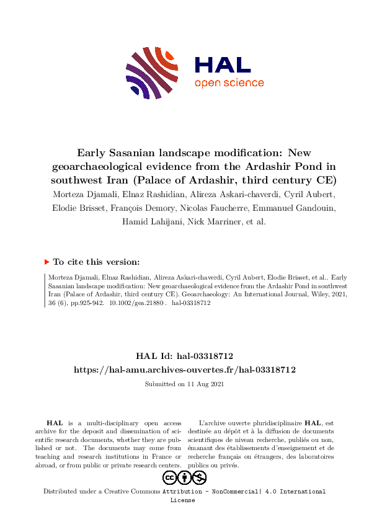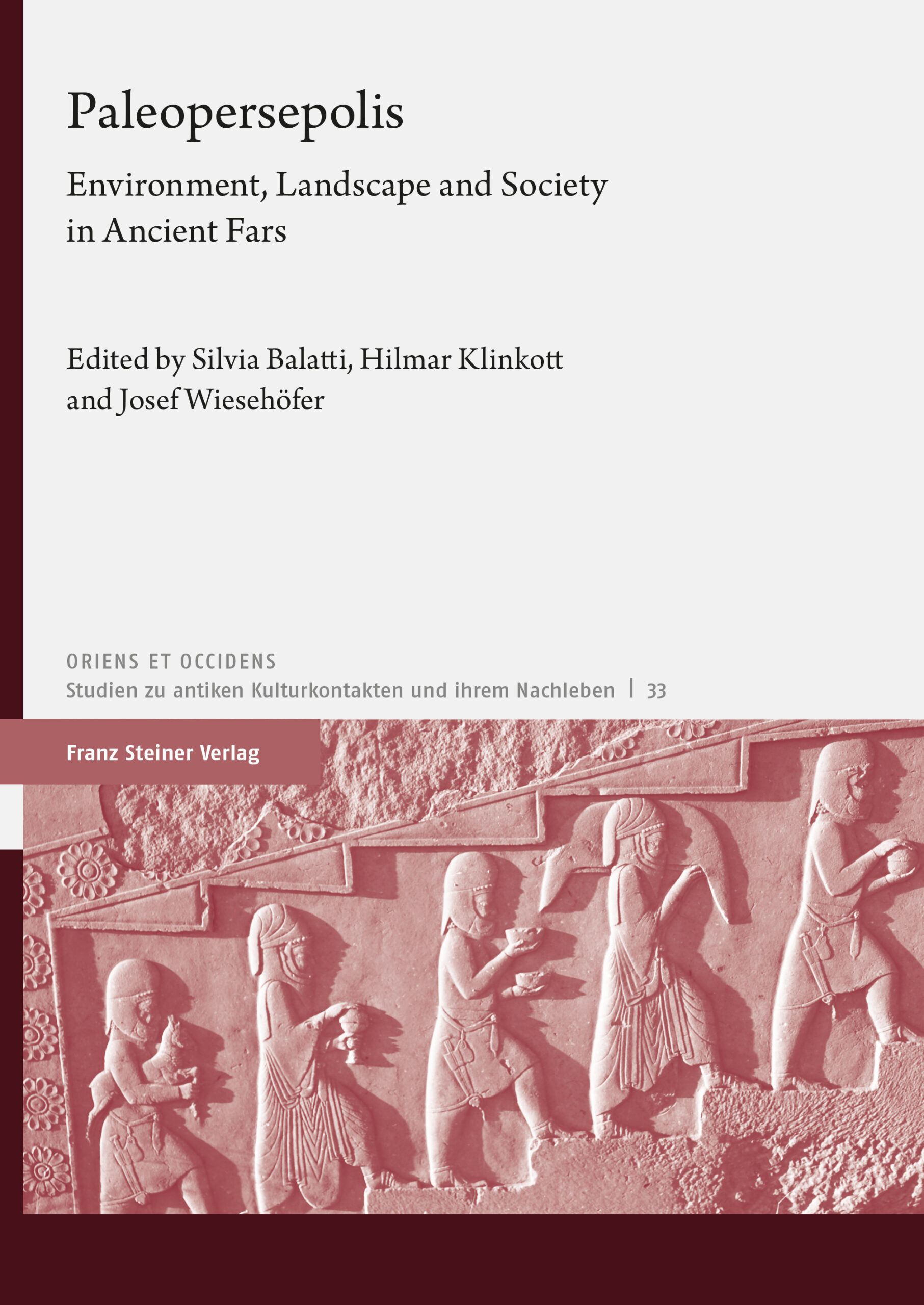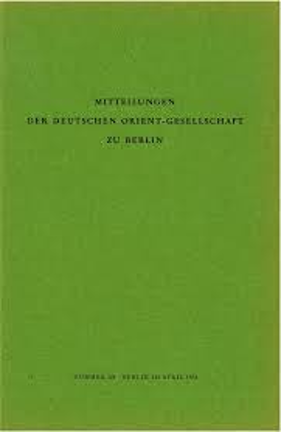Publications so far
0
| 1. |  | Franke, Kristina A.; Kouroshi, Yahya; Skowronek, Miriam; Stöllner, Thomas (Ed.): DFG-SPP 2176: The Iranian Highlands – Resiliences and Integration in Premodern Societies. Accompanying Booklet to the Special Exhibition. 2021. (Type: Booklet | Abstract | Links | BibTeX)@booklet{nokey,The DFG Priority Programme 2176 “The Iranian Highlands: Resilience and Integration in Premodern Societies” consists of 11 individual projects and a coordination programme. Our common goal is to explore early societies of the Iranian highlands and their resilience strategies. International cooperation of a large number of diff erent institutions in Europe and Iran is the basis for the research endeavour. In addition, there is intensive exchange with the “Patrimonies Project” and the project “Documentation and Historical Dialectology of Lori”, two associated projects that focus on current living conditions, the protection of cultural heritage and the study of dialects in the Iranian highlands. |
| 2. |  | Djamali, Morteza; Rashidian, Elnaz; Askari-Chaverdi, Alireza; Aubert, Cyril; Brisset, Elodie; Demory, François; Faucherre, Nicolas; Gandouin, Emmanuel; Lahijani, Hamid; Marriner, Nick; Naderi-Beni, Abdolmajid; Parnell, Andrew: Early Sasanian Landscape Modification: New Geoarchaeological Evidence From the Ardashir Pond in Southwest Iran (Palace of Ardashir, Third Century CE). In: Geoarchaeology, iss. 36, pp. 925–42, 2021. (Type: Journal Article | Abstract | Links | BibTeX)@article{nokey,The Sasanian period (224–651 CE) marked an era of large-scale urban projects in southwest Asia, including Iran's semi-arid highlands, with particular efforts to manipulate water bodies. This study presents a recent interdisciplinary investigation of a spring-fed pond at the entrance of the Palace of Ardashir (Firuzabad plain, southwest Iran), part of a recently registered World Heritage site. Historical accounts suggest that the entire water system of the plain, including the pond, underwent a hydraulic re-organization at the beginning of the Sasanian period, a fact that has never been investigated geoarchaeologically. A series of sediment cores were retrieved from the pond to probe its evolution and examine the extent of its landscape modification. The cores were sedimentologically described and radiocarbon-dated with age–depth models established based on 57 AMS (accelerator mass spectrometry) 14C dates to understand the basin's depositional history. The results indicate that (i) Ardashir Pond has existed as part of a larger wetland complex since at least 4500 years ago, (ii) it was substantially enlarged at the beginning of the Sasanian era, and (iii) it was abandoned at the end of the Sasanian period. The Ardashir Pond is one of the first geoarchaeologically investigated case studies to demonstrate the Sasanian landscape in the framework of the “Iranshahr” sociopolitical concept. |
| 3. |  | Henkelman, Wouter F. M.: The Fruits of Pārsa. In: Paleopersepolis: Environment, landscape and society in ancient Fars (Oriens et Occidens), vol. 33, pp. 133-67, 2021. (Type: Journal Article | Links | BibTeX)@article{nokey, |
| 4. |  | Brown, Michael: The Mountain Fortresses of Rabana-Merquly in Iraqi-Kurdistan. In: BAF-Online: Proceedings of the Berner Altorientalisches Forum, vol. 4, no. 1, 2020. (Type: Journal Article | Abstract | Links | BibTeX)@article{nokey,The twin fortresses of Rabana-Merquly are situated on the western side of Mt. Piramagrun, one of the most prominent massifs in the Zagros Mountains. A defining feature of these adjoining settlements are their matching, approximately life-size rock-reliefs depicting a ruler in Parthian dress, which flank the entrance to both sites. Behind the perimeter walls several structures have been recorded including a citadel and a sanctuary complex. The combined intramural area is in excess of 40 hectares. Based on the style of relief sculptures, and the material culture of their associated intramural settlements, occupation is dated to the early first millennium A.D. Investigations at Rabana-Merquly are a collaboration between Heidelberg University and the Sulaymaniyah Directorate of Antiquities. This talk gives an overview of the main fieldwork results to date, emphasizing the relationship between the fortified settlements and the wider landscape of the central Zagros highlands. |
| 5. |  | Brown, Michael; Rasheed, Kamal; Dörr, Roxana; Heiler, Jan: Die Bergbefestigung von Rabana-Merquly in Irakisch-Kurdistan: Ein Vorbericht der Grabungskampagne 2019. In: Mitteilungen der Deutschen Orient-Gesellschaft, iss. 152, pp. 91-110, 2020. (Type: Journal Article | Abstract | Links | BibTeX)@article{nokey,On the slopes of Mt. Piramagrun in the Zagros Mountains of Iraqi Kurdistan lies the fortified site of Rabana-Merquly. Ruins spread across c. 100 ha represent a major occupation during the Parthian period. Matching rock-reliefs that depict an anonymous ruler flank the two main entrances to the settlements. Pronounced similarities in attire between these sculptures and the statue of a king of Adiabene found at Hatra suggest a possible identification for both the individual depicted in relief (Natounissar) and the ancient city (Natounia-on-the-Kapros). Fieldwork in 2019 continued our ongoing programme of survey and excavation, with more detailed investigation of the complex at the entrance to Rabana valley. |
| 6. |  | Maziar, Sepideh; Zalaghi, Ali: Exploring Beyond the River and Inside the Valleys: Settlement Development and Cultural Landscape of the Araxes River Basin Through Time. In: Iran, iss. 59, pp. 36–56, 2020. (Type: Journal Article | Abstract | Links | BibTeX)@article{nokey,Geographical landmarks, especially rivers, have always played an important role in forming or hampering interplay between societies. In some cases, they act as a “communication route” and in some others as “obstacles”. In north-western Iran, it is possible that the Araxes River played such a decisive role by sculpting its surroundings. While our studies are not yet sufficiently adequate to understand the exact role of this river in different time spans, we can begin in some way to conceptualise its role in different periods. The Araxes Valley Archaeological Project (AVAP) was developed with the general aim of investigating settlement development from the fifth to the third millennium BC. Furthermore, studying the possible and probable routes of interaction, both inter- and intra-regional, between the Jolfa and Khoda Afarin plains and the southern Caucasus and north-western Iran, networks of contacts and exchange, and gaining a better understanding of the geographical characteristics of this area and its landscape were among our aims. In this article, the general history of occupation along this river is given to provide a preliminary database to understand the geographical and socio-political potential of this part in order to pursue more comprehensive studies in the future. |
2021 |
|
 | Franke, Kristina A.; Kouroshi, Yahya; Skowronek, Miriam; Stöllner, Thomas (Ed.): DFG-SPP 2176: The Iranian Highlands – Resiliences and Integration in Premodern Societies. Accompanying Booklet to the Special Exhibition. 2021. (Type: Booklet | Abstract | Links | BibTeX | Tags: Administration, Institutions, Integration, Landscape, Mobility, Resilience, Resources)@booklet{nokey,The DFG Priority Programme 2176 “The Iranian Highlands: Resilience and Integration in Premodern Societies” consists of 11 individual projects and a coordination programme. Our common goal is to explore early societies of the Iranian highlands and their resilience strategies. International cooperation of a large number of diff erent institutions in Europe and Iran is the basis for the research endeavour. In addition, there is intensive exchange with the “Patrimonies Project” and the project “Documentation and Historical Dialectology of Lori”, two associated projects that focus on current living conditions, the protection of cultural heritage and the study of dialects in the Iranian highlands. |
 | Djamali, Morteza; Rashidian, Elnaz; Askari-Chaverdi, Alireza; Aubert, Cyril; Brisset, Elodie; Demory, François; Faucherre, Nicolas; Gandouin, Emmanuel; Lahijani, Hamid; Marriner, Nick; Naderi-Beni, Abdolmajid; Parnell, Andrew: Early Sasanian Landscape Modification: New Geoarchaeological Evidence From the Ardashir Pond in Southwest Iran (Palace of Ardashir, Third Century CE). In: Geoarchaeology, iss. 36, pp. 925–42, 2021. (Type: Journal Article | Abstract | Links | BibTeX | Tags: Fars, Landscape, Sasanian)@article{nokey,The Sasanian period (224–651 CE) marked an era of large-scale urban projects in southwest Asia, including Iran's semi-arid highlands, with particular efforts to manipulate water bodies. This study presents a recent interdisciplinary investigation of a spring-fed pond at the entrance of the Palace of Ardashir (Firuzabad plain, southwest Iran), part of a recently registered World Heritage site. Historical accounts suggest that the entire water system of the plain, including the pond, underwent a hydraulic re-organization at the beginning of the Sasanian period, a fact that has never been investigated geoarchaeologically. A series of sediment cores were retrieved from the pond to probe its evolution and examine the extent of its landscape modification. The cores were sedimentologically described and radiocarbon-dated with age–depth models established based on 57 AMS (accelerator mass spectrometry) 14C dates to understand the basin's depositional history. The results indicate that (i) Ardashir Pond has existed as part of a larger wetland complex since at least 4500 years ago, (ii) it was substantially enlarged at the beginning of the Sasanian era, and (iii) it was abandoned at the end of the Sasanian period. The Ardashir Pond is one of the first geoarchaeologically investigated case studies to demonstrate the Sasanian landscape in the framework of the “Iranshahr” sociopolitical concept. |
 | Henkelman, Wouter F. M.: The Fruits of Pārsa. In: Paleopersepolis: Environment, landscape and society in ancient Fars (Oriens et Occidens), vol. 33, pp. 133-67, 2021. (Type: Journal Article | Links | BibTeX | Tags: Environmental conditions, Landscape, Social, social relations)@article{nokey, |
2020 |
|
 | Brown, Michael: The Mountain Fortresses of Rabana-Merquly in Iraqi-Kurdistan. In: BAF-Online: Proceedings of the Berner Altorientalisches Forum, vol. 4, no. 1, 2020. (Type: Journal Article | Abstract | Links | BibTeX | Tags: Fortification, Kurdistan, Landscape, Parthian, Persian empire, Resilience)@article{nokey,The twin fortresses of Rabana-Merquly are situated on the western side of Mt. Piramagrun, one of the most prominent massifs in the Zagros Mountains. A defining feature of these adjoining settlements are their matching, approximately life-size rock-reliefs depicting a ruler in Parthian dress, which flank the entrance to both sites. Behind the perimeter walls several structures have been recorded including a citadel and a sanctuary complex. The combined intramural area is in excess of 40 hectares. Based on the style of relief sculptures, and the material culture of their associated intramural settlements, occupation is dated to the early first millennium A.D. Investigations at Rabana-Merquly are a collaboration between Heidelberg University and the Sulaymaniyah Directorate of Antiquities. This talk gives an overview of the main fieldwork results to date, emphasizing the relationship between the fortified settlements and the wider landscape of the central Zagros highlands. |
 | Brown, Michael; Rasheed, Kamal; Dörr, Roxana; Heiler, Jan: Die Bergbefestigung von Rabana-Merquly in Irakisch-Kurdistan: Ein Vorbericht der Grabungskampagne 2019. In: Mitteilungen der Deutschen Orient-Gesellschaft, iss. 152, pp. 91-110, 2020. (Type: Journal Article | Abstract | Links | BibTeX | Tags: Fortification, Kurdistan, Landscape, Parthian, Resilience)@article{nokey,On the slopes of Mt. Piramagrun in the Zagros Mountains of Iraqi Kurdistan lies the fortified site of Rabana-Merquly. Ruins spread across c. 100 ha represent a major occupation during the Parthian period. Matching rock-reliefs that depict an anonymous ruler flank the two main entrances to the settlements. Pronounced similarities in attire between these sculptures and the statue of a king of Adiabene found at Hatra suggest a possible identification for both the individual depicted in relief (Natounissar) and the ancient city (Natounia-on-the-Kapros). Fieldwork in 2019 continued our ongoing programme of survey and excavation, with more detailed investigation of the complex at the entrance to Rabana valley. |
 | Maziar, Sepideh; Zalaghi, Ali: Exploring Beyond the River and Inside the Valleys: Settlement Development and Cultural Landscape of the Araxes River Basin Through Time. In: Iran, iss. 59, pp. 36–56, 2020. (Type: Journal Article | Abstract | Links | BibTeX | Tags: Armenia, Azerbaijan, Bronze Age, Caucasus, Chalcolithic, Georgia, Iron Age, Kura-Araxes, Landscape, Mobility, Neolithic, Settlement and subsistance systems, Settlement mobility, Settlement structure, Structure development)@article{nokey,Geographical landmarks, especially rivers, have always played an important role in forming or hampering interplay between societies. In some cases, they act as a “communication route” and in some others as “obstacles”. In north-western Iran, it is possible that the Araxes River played such a decisive role by sculpting its surroundings. While our studies are not yet sufficiently adequate to understand the exact role of this river in different time spans, we can begin in some way to conceptualise its role in different periods. The Araxes Valley Archaeological Project (AVAP) was developed with the general aim of investigating settlement development from the fifth to the third millennium BC. Furthermore, studying the possible and probable routes of interaction, both inter- and intra-regional, between the Jolfa and Khoda Afarin plains and the southern Caucasus and north-western Iran, networks of contacts and exchange, and gaining a better understanding of the geographical characteristics of this area and its landscape were among our aims. In this article, the general history of occupation along this river is given to provide a preliminary database to understand the geographical and socio-political potential of this part in order to pursue more comprehensive studies in the future. |
